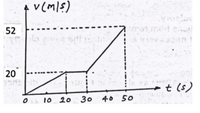
College Physics
11th Edition
ISBN: 9781305952300
Author: Raymond A. Serway, Chris Vuille
Publisher: Cengage Learning
expand_more
expand_more
format_list_bulleted
Concept explainers
Question
Q) The race car starts from rest and travels along a straight road until it reaches a speed of 52 m/s in 50 seconds as shown by v-t graph in Fig. Determine the distance travelled by race car in 50 seconds. Draw s-t and a-t graph

Transcribed Image Text:52
o gros ot
20
STUTA
et (s)
O
10 20 30 40 50
Expert Solution
This question has been solved!
Explore an expertly crafted, step-by-step solution for a thorough understanding of key concepts.
Step by stepSolved in 3 steps with 3 images

Knowledge Booster
Learn more about
Need a deep-dive on the concept behind this application? Look no further. Learn more about this topic, physics and related others by exploring similar questions and additional content below.Similar questions
- O 2/m/s/s A bicyclist accelerates at 0.89 m/s^2 duringa 5s interval. If she started at 2.3m/s, what was the final speed of the bicyclist?* ) 10.61m/s O6.75m/s 4.45m/s 2.15m/s Which d/t graph matches the following v/t graph?*arrow_forwardWhich (if either) has the greater average speed? a- a truck that travels from milepost 92 to milepost 100 in 10 minutes b- car that travels from milepost 113 to milepost 120 in 10 minutes. Im not understanding how to work this problem because a- is going 8 miles. b- is going 7 miles. So would neither have the greater average speed?arrow_forwardNeeds Complete typed solution with 100 % accuracy.arrow_forward
- 7) A speeding motorist traveling 30 m/s passes a stationary police officer. The officer immediately begins pursuit at a constant acceleration of 3 m/s². a) How much time will it take for the police officer to reach the speeder? b) What is the velocity of officer when he catches the speeder? c) Plot two graphs, show the displacement vs. time for both motorist and police in one graph and velocity vs. time for both of them in a the other graph.arrow_forwardS-1 pt S-1 pt 1. Jason is racing his dirt bike and comes out of a turn into a long straightaway going a velocity of 15m/s and accelerates at a rate of 2m/s^2. Jason accelerates for 6 seconds. How much distance does Jason cover in that time period? G-Given (what are the givens in the problem) * v-15m/sarrow_forwardThe house, school, and diner are on the same street. The house is 820 ft from the school and 0.6 miles from the diner. Assume the positive direction is to the LEFT ←. If you start from the diner, head to the house, and then go back to the diner in 2 hr., what is your average velocity in cm/s to two significant figures? HH 188 A. 0.6 cm/s B. 26.8 cm/s C.-27 cm/s D. 0.0 cm/s E. none of the above SCHOOL DINERarrow_forward
- Context The position of a peculiar fish as a function of time is given by the following equation. Time is in seconds, position is in meters, and the positive direction is to the right. x(t) = 2t3 + 12t2 - 72t The fish's position, velocity, and acceleration functions are x = 2t3 + 12t2 - 72t, v = 6t2 + 24t - 72, and a = 12t + 24. Question: When, if ever, is the fish at rest? Drag the appropriate label(s) to the correct location(s) on the number line. Remember that it is the circle in the upper left corner of the label that must be in the correct place. Drag the period (.) to denote a single time; for example, t=0. Drag the left bracket ([) to denote the lower end of a range; for example, t>0. Drag the right bracket (]) to denote the upper end of a range; for example, t<0. Drag "none" anywhere near the line if the fish is never at rest. You may place as many of each symbol on the line as needed. See image attached:arrow_forwardYou are driving at night on a straight path at 70MPH. Suddenly, a dog appears in your headlights 35 meters away. You immediatley apply the brakes which causes your car to slow down at a constant rate, coming to rest just before making contact with the dog. 1 mile = 1.61 km 1) How long did it take for your car to make a complete stop? 2) If you were initially driving in the 'positive x' direction, then what was your acceleration during the braking maneuver, in vector form and in m/s2?arrow_forward
arrow_back_ios
arrow_forward_ios
Recommended textbooks for you
 College PhysicsPhysicsISBN:9781305952300Author:Raymond A. Serway, Chris VuillePublisher:Cengage Learning
College PhysicsPhysicsISBN:9781305952300Author:Raymond A. Serway, Chris VuillePublisher:Cengage Learning University Physics (14th Edition)PhysicsISBN:9780133969290Author:Hugh D. Young, Roger A. FreedmanPublisher:PEARSON
University Physics (14th Edition)PhysicsISBN:9780133969290Author:Hugh D. Young, Roger A. FreedmanPublisher:PEARSON Introduction To Quantum MechanicsPhysicsISBN:9781107189638Author:Griffiths, David J., Schroeter, Darrell F.Publisher:Cambridge University Press
Introduction To Quantum MechanicsPhysicsISBN:9781107189638Author:Griffiths, David J., Schroeter, Darrell F.Publisher:Cambridge University Press Physics for Scientists and EngineersPhysicsISBN:9781337553278Author:Raymond A. Serway, John W. JewettPublisher:Cengage Learning
Physics for Scientists and EngineersPhysicsISBN:9781337553278Author:Raymond A. Serway, John W. JewettPublisher:Cengage Learning Lecture- Tutorials for Introductory AstronomyPhysicsISBN:9780321820464Author:Edward E. Prather, Tim P. Slater, Jeff P. Adams, Gina BrissendenPublisher:Addison-Wesley
Lecture- Tutorials for Introductory AstronomyPhysicsISBN:9780321820464Author:Edward E. Prather, Tim P. Slater, Jeff P. Adams, Gina BrissendenPublisher:Addison-Wesley College Physics: A Strategic Approach (4th Editio...PhysicsISBN:9780134609034Author:Randall D. Knight (Professor Emeritus), Brian Jones, Stuart FieldPublisher:PEARSON
College Physics: A Strategic Approach (4th Editio...PhysicsISBN:9780134609034Author:Randall D. Knight (Professor Emeritus), Brian Jones, Stuart FieldPublisher:PEARSON

College Physics
Physics
ISBN:9781305952300
Author:Raymond A. Serway, Chris Vuille
Publisher:Cengage Learning

University Physics (14th Edition)
Physics
ISBN:9780133969290
Author:Hugh D. Young, Roger A. Freedman
Publisher:PEARSON

Introduction To Quantum Mechanics
Physics
ISBN:9781107189638
Author:Griffiths, David J., Schroeter, Darrell F.
Publisher:Cambridge University Press

Physics for Scientists and Engineers
Physics
ISBN:9781337553278
Author:Raymond A. Serway, John W. Jewett
Publisher:Cengage Learning

Lecture- Tutorials for Introductory Astronomy
Physics
ISBN:9780321820464
Author:Edward E. Prather, Tim P. Slater, Jeff P. Adams, Gina Brissenden
Publisher:Addison-Wesley

College Physics: A Strategic Approach (4th Editio...
Physics
ISBN:9780134609034
Author:Randall D. Knight (Professor Emeritus), Brian Jones, Stuart Field
Publisher:PEARSON